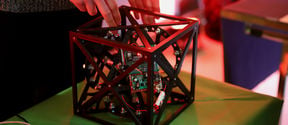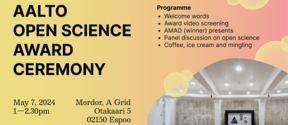How ecological is AI? How can you compose with a neural network? Come to AI exhibition to find out!

Time: November 27 - January 15
Place: Dipoli, Otakaari 24, Espoo
Aalto Digi Platform and FCAI are hosting a science and art exhibition that takes its visitors to a journey in the world of Artificial Intelligence. The Connecting the Dots exhibition, taking place at Aalto University’s campus in Espoo, Finland, aims to increase our understanding about the history of AI, the current state of art, and what the future holds.
“AI is already part of our everyday life, but what we can do with it and how it works is still quite a mystery to most people. With this exhibition, we hope to give answers to questions they may have,” says Saara Halmetoja, the exhibition coordinator from Aalto Digi Platform.
The exhibition is suitable for people of all ages. Visitors can step into a sound environment in which they can control the surrounding voices with their movements; compete against AI in a music game; and compose together with a neural network, among other activities.
The exhibition dives into the core of AI research. Visitors will see how a machine learns to classify and predict things, as well as how it forms sounds, pictures, text, and molecules. The exhibition presents robotics and shows how AI adapts to real-world situations.
Connecting the Dots discusses the history and ecological aspects of AI. While AI can help the clothing industry in getting rid of textile waste, artificial neural networks – mimicking human brain’s neural networks – consume enormous amounts of energy.
The exhibition brings together the diverse fields of Aalto University from natural sciences, technology, and architecture to design and arts. The scientists, artists, and students behind the exhibition come from diverse backgrounds; some of them are “pure” AI researchers, while others use AI tools in their scientific or artistic work.
According to Halmetoja, “if only certain types of people take part in discussions about AI, we will end up designing discriminatory technology. Therefore, we need to make sure that everyone in the society participates in these discussions”
Entrance to the Connecting the Dots exhibition is free and the event is open during Dipoli’s normal opening hours from November 27 until January 15. For larger groups, such as school groups, the minimum age recommendation is 12 years old. If you want to visit the exhibition with a group of people, please contact Saara Halmetoja, the exhibition coordinator, in advance.
Further information
Saara Halmetoja
Exhibition Coordinator
Aalto Digi Platform
Phone +358 50 5720730
[email protected]
- Published:
- Updated:
Read more news

Aalto ARTS alum Vidha Samya’s artwork featured at the Venice Biennale 2024
The Pavilion of Finland presents ‘The pleasures we choose’ at the 60th International Art Exhibition – La Biennale di Venezia until 24 November 2024.
IoT Forge donates EUR 1 million to the School of Engineering
The donation will be used for research and education on the Industrial Internet and digital twins.
Join us for the first Aalto Open Science Award Ceremony
All Aaltonians are welcome – no registration required!